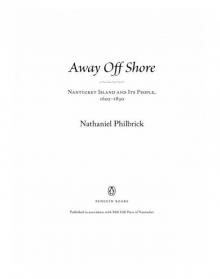- Home
- Nathaniel Philbrick
Away Off Shore: Nantucket Island and Its People, 1602-1890 Page 9
Away Off Shore: Nantucket Island and Its People, 1602-1890 Read online
Page 9
Unfortunately, we know precious little about the man. Although he came to Nantucket in 1690, he was back in his hometown, Yarmouth on Cape Cod, by 1710, when he was granted seven and a half shares of common land. His brothers, however, Nathaniel and Joseph, stayed on the island, and it would be Ichabod’s niece, Love, who would let out the water from Lily Pond. Indeed, there seems to have been something mischievous and daring about the Paddocks, who had a difficult time maintaining the proper level of Quaker-required decorum throughout the eighteenth century. In 1730, Nathaniel Paddock was censored by the Monthly Meeting for having been “excessive in taking of strong liquor to [his] own scandal and shame.” And then in 1781, a kinsman named for the illustrious father of all Nantucket whalemen, Ichabod Paddock, was “disowned” by the Quakers for having “sailed about in a vessel where dancing was performed and he a partaker therein.”
When it comes to the original Ichabod Paddock, however, all we have is a legend that has been passed down to us involving a green-eyed mermaid. As was true with the Indian legends, this tale, if not historically correct, is an important indication of the emotional and cultural truth of what it was Ichabod Paddock started on Nantucket. But first a little background.
The sighting of mermaids and mermen was a fairly regular occurrence in the early eighteenth century, particularly in the neighborhood of Nantucket. In 1714, a sojourner by the name of Valentyn was on a ship in the vicinity of Nantucket when he and other members of the crew spotted “a creature of a grizzlish, or gray color, like that of a codfish skin” who “appeared like a sailor, or a man.” Before Valentyn could take a closer look, the merman dove underwater, revealing to the man at the masthead “a monstrous long tail.” About this same time the crew of yet another ship passing near Great Point spotted a mermaid cavorting in the sea. According to one account, she swam ashore and disappeared into the “strange forest” that then existed on what is now a treeless sand spit. Two hundred years later, the lighthouse keeper at Great Point determined that someone had been living in this forest, and there were many on Nantucket who claimed it had been the mermaid’s hiding place.
As might be expected, Ichabod Paddock’s connection with a mermaid came as a consequence of a run-in with a whale, a big bull sperm whale by the name of Crook-Jaw. In the tradition of Moby Dick, Crook-Jaw confounded all of Ichabod’s attempts to harpoon him. No matter how many harpoons he might heave, none of them succeeded in fastening to the tough-skinned whale. But Ichabod, who had a reputation to uphold, was not about to give up.
One warm, sunny day, after hours of unsuccessfully pursuing old Crook-Jaw, he decided it was time to discover what made this monster tick. With his knife clenched between his teeth, he leapt into the ocean. It was a fairly calm day, and as his crew looked on in horror, Ichabod swam up to the whale and waited for him to open his huge gnarled jaws. Growing bored with the proceedings, the whale yawned, and in swam Ichabod, a voluntary Jonah.
What he found inside amazed him. Instead of chewed-up squid and stomach lining, he found himself face-to-face with the door to a ship’s cabin. Inside the lamp-lit room were two figures on opposite sides of a table playing cards. One was a gorgeous, emerald-eyed mermaid, with flaxen blond hair and not a stitch of clothing to conceal what was a very human and well-developed body above the glittering scales of her fishy tail; the other was the Devil. Suddenly the Devil threw down his cards and cursed, and eyeing Ichabod with bitter contempt, vanished in a puff of foul-smelling, tryhouse smoke.
Ichabod politely apologized to the bewitching mermaid for interrupting her card game, then asked what had been the stakes. The mermaid laughed coquettishly. “The stakes, Captain Paddock?” she asked. “Why, they were you!”
Meanwhile, back on Ichabod’s whaleboat, his crew had given him up for lost, but being a loyal crew they waited out the night beside the weirdly passive Crook-Jaw. As they slept on their oars, the crew was suddenly awakened the next morning by the sound of a very weary but surprisingly content Captain Ichabod swimming toward them.
After returning to his ship for the day, Ichabod and crew were once again back out that evening; and once again he spent the night within the belly of the whale. This continued for several voyages until Ichabod’s wife, hearing some of the wild rumors that had been told by the crew, began to grow suspicious.
The next time Ichabod came ashore, his wife—a beautiful woman in her own right and not yet thirty—presented him with a gift: a shiny, freshly forged harpoon. Whatever guilt Ichabod felt was not enough to keep him from setting out the next day, but this time his wife had a request: could he take her father along? Whaling with his father-in-law was not exactly what Ichabod had in mind, but he reluctantly agreed.
Soon old Crook-Jaw once again came in sight. By now the whale had become accustomed to Ichabod’s appearances and rather than swimming away from the whaleboat, he waited patiently for its arrival. Confident that it would prove impossible to fasten to the whale, Ichabod watched his father-in-law take up the new harpoon and hurl it at Crook-Jaw. To his astonishment, the harpoon held, and it was not long before the whale was in its final flurry.
Back at the ship, Ichabod watched tensely as they cut into the whale. But where there had once been a ship’s cabin all he found was a strand of yellow seaweed and two green, glittering shells. It was not until long after they had left Nantucket and returned to Yarmouth that Ichabod’s wife confessed to what she had done. It had been no ordinary harpoon she had given him; instead of iron it had been fashioned out of silver—the only metal that will pierce the heart of a witch.
Ichabod Paddock introduced the Nantucketers to something more than a new occupation; he introduced them to a whole new way of life, that of the sea. Terrifyingly unpredictable, it could also be tantalizingly alluring, with Ichabod’s mermaid finding her real-life embodiment in the South Sea maidens who would tempt future generations of islanders in the nineteenth century. And so, with this tall tale as a beginning, let us now examine the historical circumstances surrounding the rise of whaling on Nantucket.
According to Obed Macy, it all started when a “scrag” (otherwise known as an Atlantic gray) whale found its way into Nantucket Harbor perhaps a decade after the arrival of the English. In those days whales were a common sight throughout the Cape and islands; in fact, when the Mayflower sailed from Provincetown Harbor to Plymouth in 1620, the Pilgrims found themselves literally surrounded by whales “playing hard by us.” Although dead or “drift” whales commonly washed up along the southwestern shore of the island, the Indians still exercised their traditional right of control over these whales. In typical fashion, however, the Gardners seem to have worked out their own deal with the Indians, for in 1668 Edward Starbuck and Peter Folger were appointed “to make a bargain with the Gardners concerning all the whales that shall come on shore on the island on the town’s behalf.”
This whale, however, was different. It was alive, and no one on this island of mostly farmers and sheepherders seems to have known what to do about it. As large numbers of townspeople lined the “high cliff” along which now runs Orange Street and watched the disoriented whale spout and churn the waters from Brant Point to Wauwinet, others in the town, no doubt supervised by the Gardners, “invented and caused to be wrought for them a harpoon.” On the third day of the whale’s captivity within the shielding arm of Coatue, an unnamed Nantucketer began what would become a 200-year tradition by successfully killing the sea mammal with the brand-new harpoon.
Since it had already become clear that they were not going to get rich by raising sheep, the Nantucketers were eager to exploit this new and potentially lucrative endeavor. So in 1672 the town looked to the eastern end of Long Island, where along-shore whaling had been going on since the 1640s, offering one James Lopar, a whaleman from Southampton, and John Savage, a cooper, the opportunity to set up a whaling business on Nantucket. Although Savage did decide to relocate, there is no evidence that Lopar ever left Long Island.
Then in 1690, with King P
hilip’s War and the Half-Share Revolt safely behind them, the townspeople looked across the Sound to Cape Cod, where in Yarmouth there was a twenty-eight-year-old fisherman by the name of Ichabod Paddock with a reputation as one of the region’s most proficient whalemen. Since his students would go on to become the foremost whalers in the world, he must have been, at the very least, a good teacher. Certainly Ichabod’s timing was excellent. In 1692, two years after his arrival on Nantucket, the fledgling whale fishery received an important boost when the island came under the jurisdiction of Massachusetts. Unlike New York, the Bay Colony did not tax whale oil, placing the Nantucketers in a much more advantageous position relative to their predecessors on Long Island.
The Nantucketers also desperately needed whaling not only in an economic but also in an ecological sense. The town records throughout the 1680s and ’90s are filled with measures to conserve and protect grass and farmlands as well as trees. With an ever-expanding population, the pressure was mounting on Nantucket as the English and Indians vied for an ever-diminishing supply of natural resources. In this respect, whaling was for Nantucket what the frontier would be for the nation, providing the island with an escape valve through which to vent the increasing pressures of a growing population. Here at last was a way for the islanders to make a living that did not depend on the productivity of Nantucket’s not-so fertile land.
Almost immediately the town seized upon this new endeavor with a desperate and thankful excitement. When it came to whaling, the selectmen were willing to make an exception to the normally strict rules against cutting lumber. In an order against cutting cedar trees on Coatue made in April of 1695 is this caveat: “nevertheless any freeholder may cut timber for whaleboats or the like, anything in this order to the contrary notwithstanding.” Whaling was where the money was, and nothing, not even the loss of almost every tree on the island, was going to get in the Nantucketers’ way. They would come to regard this newfound occupation with an almost religious enthusiasm. In the same year Ichabod Paddock came to the island, some Nantucketers were on a high hill on the south side of the island watching “the whales spouting and sporting with each other, when one observed, ‘There,’ pointing to the sea, ‘is a green pasture where our children’s grandchildren will go for bread.’ ”
By 1700, anyone who could hold an oar—English and Indian alike—was involved in the whale fishery, which in those days lasted from November into late March and early April, dovetailing nicely with the seasonal demands of farming and sheep grazing. At this point, the fishery had the potential to have a positive effect on English-Indian relations, with approximately 60 English and 160 Indian shore whalers on Nantucket by the turn of the century. According to Obed Macy:When the English began to establish themselves in the whaling business, the Indians showed a readiness to join in and were preferred to the whites in some parts of the business. They were a stout, strong race of people and generally very industrious, never gave back but were always ready to go forward where they were sent by the captain. Some of them were capable men, and men of good judgment, so much so that they were often promoted to a station above a common hand, even to head a boat, and were as dextrous as the whites. I have known instances of the whole crew on board to be Indians except the Master.
As Elizabeth Little has pointed out, shore whaling enabled Nantucket’s Native Americans to earn up to four times the annual wage of a Boston seaman in the first half of the century. However, as the Indian population shrank and the whale fishery expanded, the English began to rely increasingly on the age-old system of debt servitude to maintain a steady supply of Indian crew members. According to the estimates of Daniel Vickers, about three-fourths of the Native Americans that served on Nantucket whaleboats between 1725 and 1733 were working not for themselves but for their “masters.”
In the early days whaling was conducted in small, twenty-foot open boats that would in time evolve into the whaleboats carried throughout the world from the davits of Nantucket whaleships. Although their light, double-ended design may have been influenced by the Indian canoe, Spanish and French Basques had been whaling from boats of a similar appearance since the Middle Ages.
The whale of choice at this time was the relatively mild-mannered right whale, so named because it was “the right whale to catch,” in part because it did not sink after it was killed. Crèvecoeur, writing several years after along-shore whaling had ceased on Nantucket, describes how the islanders organized themselves into whale stations:The south sides of the island, from east to west, were divided into four equal parts, and each part was assigned to a company of six, which, though thus separated, still carried on their business in common. In the middle of this distance, they erected a mast . . . and near it they built a temporary hut, where five of the associates lived, whilst the sixth from his high station carefully looked toward the sea in order to observe the spouting of the whales. As soon as they were discovered, the sentinel descended, the whale-boat was launched, and the company went forth in quest of their game.
In the first Proprietors’ Book is a sketch from 1776 of a whale station on the southeastern end of the island. On either side of a two-sectioned spar are a row of tiny shacks, all of which feature a chimney (this was, after all, a winter-time occupation). It was shacks such as these, moved from whaling and fishing stations throughout the island, that would ultimately make up the village of Siasconset.
Ironically, given the modern-day slogan for putting a halt to all whaling, the process of extracting oil from the dead sea mammal was known as “saving the whale.” Obed Macy describes the process: “After the whale had been killed and towed ashore, a crab was used, an instrument similar to a capstan, to heave and turn the blubber off as fast as it was cut. The blubber was then put into their carts and carried to their tryhouses, which at that early period, were placed near to their dwelling houses, where the oil was boiled out and fitted for market.”
The method of crew payment that developed on Nantucket, which would ultimately become known as the American “lay system,” was entirely different from what was practiced on European whalers, where crew members received wages. On Nantucket, each member of the crew received a prearranged share of the oil and bone taken in each voyage, thus providing an incentive to all members of the crew to take risks that they might not have been willing to endure if they had not had a direct stake in the success of the voyage. Indeed, it is hard to conceive of a more dangerous occupation: rowing around in tiny boats, miles from shore in the dead of winter in the pursuit of a whale that could flip over the entire boat with a flick of its tail. Tradition has it, however, that in the whole history of shore whaling on Nantucket, not a single white man was lost. (The Native Americans, apparently, were not so lucky.) According to Obed Macy, this safety record could be attributed in part to the weather in the first half of the eighteenth century, which was “not so windy and boisterous at that time as present.” Taking advantage of calms that often lasted “a week or even a fortnight,” the whalemen “sometimes . . . ventured off in their boats nearly out of sight of land.”
The biggest year for along-shore whaling on Nantucket was 1726, when a total of eighty-six whales were taken, including eleven whales in a single day! Since a single sixty-barrel whale was worth more than a half year’s wages (on land) for each oarsman, this was a very good year indeed. Providing an indication as to who was who among Nantucket’s second and third generation of whalers is the following list of boat captains and the number of whales taken in that banner year:John Swain, 4; Andrew Gardner, 4; Jonathan Coffin, 4; Paul Paddack [a variation of Paddock], 4; Jason Johnston, 5; Clothier Pierce, 3; Sylvanus Hussey, 2; Nathan Coffin, 4; Peter Gardner, 4; William Gardner, 2; Abishai Folger, 6; Nathan Folger, 4; John Bunker, 1; Shubael Folger, 5; Shubael Coffin, 3; Nathaniel Allen, 3; Edward Heath, 4; George Hussey, 3; Benjamin Gardner, 3; George Coffin, 1; Richard Coffin, 1; Nathaniel Paddack, 2; Joseph Gardner, 1; Matthew Jenkins, 3; Bartlett Coffin, 4; Daniel Gould, 1; Ebenezer Gardner, 4;——Staples, 1.
/>
According to Macy, this shore whaling “continued until about the year 1760, when the whales became scarce, and it was by degrees discontinued.”
Early in the eighteenth century, the Nantucketers had their first encounter with what was to become their post-shore whaling destiny—not the relatively mild-mannered right whale, but the aggressive, tooth-jawed sperm whale—when one was found washed up dead on the southwestern part of the island. According to Macy, the carcass “caused considerable excitement,” and after a squabble over whose whale it was (see Chapter 9), the islanders became convinced that the “sperm procured from the head” was a nostrum that could cure all ills, and according to Macy it was soon “worth its weight in silver” on the island.
Then in 1712, after being blown offshore by a northerly gale, a Hussey and his whaleboat crew found themselves in the midst of a school of whales with an altogether different spout from what they were used to. Instead of a right whale’s forked plume, these whales puffed out a single, forward-arching spout. The Nantucketers soon realized that this was a school of sperm whales, and even though the weather was very rough, they quickly fastened to a whale. According to legend, the blood of the freshly killed whale stilled the waters in an almost biblical fashion, and Hussey was able to bring back his prize to Nantucket.
In the words of Obed Macy, this brought “a new life” to whaling on Nantucket, and it was not long before sailing vessels in the range of thirty tons were fitted out to go whaling in what was referred to as “the Deep.” These local cruises lasted in the neighborhood of six weeks. After killing a whale and filling up a few hogsheads with the slabs of its blubber, the sloop returned to Nantucket where the owner took possession of the blubber and sent the ship out again in search of more whales. Nantucket shipowners were not about to absorb the additional cost of these newer and larger whaling vessels. In one deft stroke they cut the lay of the crew in half (relative to what it was in shore whaling), providing the shipowner with a much larger stake in the voyage. Whether or not an ironical reference to the uprising of the previous century was intended, these offshore whalers came to be known as “half-share men,” a term that was in common usage as late as the 1760s.

 Bunker Hill: A City, a Siege, a Revolution
Bunker Hill: A City, a Siege, a Revolution Why Read Moby-Dick?
Why Read Moby-Dick? Second Wind: A Nantucket Sailor's Odyssey
Second Wind: A Nantucket Sailor's Odyssey The Last Stand: Custer, Sitting Bull, and the Battle of the Little Bighorn
The Last Stand: Custer, Sitting Bull, and the Battle of the Little Bighorn In the Heart of the Sea: The Epic True Story That Inspired Moby-Dick
In the Heart of the Sea: The Epic True Story That Inspired Moby-Dick Away Off Shore: Nantucket Island and Its People, 1602-1890
Away Off Shore: Nantucket Island and Its People, 1602-1890 The Mayflower and the Pilgrims' New World
The Mayflower and the Pilgrims' New World The Last Stand: Custer, Sitting Bull and the Battle of the Little Big Horn
The Last Stand: Custer, Sitting Bull and the Battle of the Little Big Horn Second Wind
Second Wind Away Off Shore
Away Off Shore The Mayflower and the Pilgrims' New World*
The Mayflower and the Pilgrims' New World* Sea of Glory
Sea of Glory In the Heart of the Sea
In the Heart of the Sea The Last Stand
The Last Stand In the Hurricane's Eye
In the Hurricane's Eye